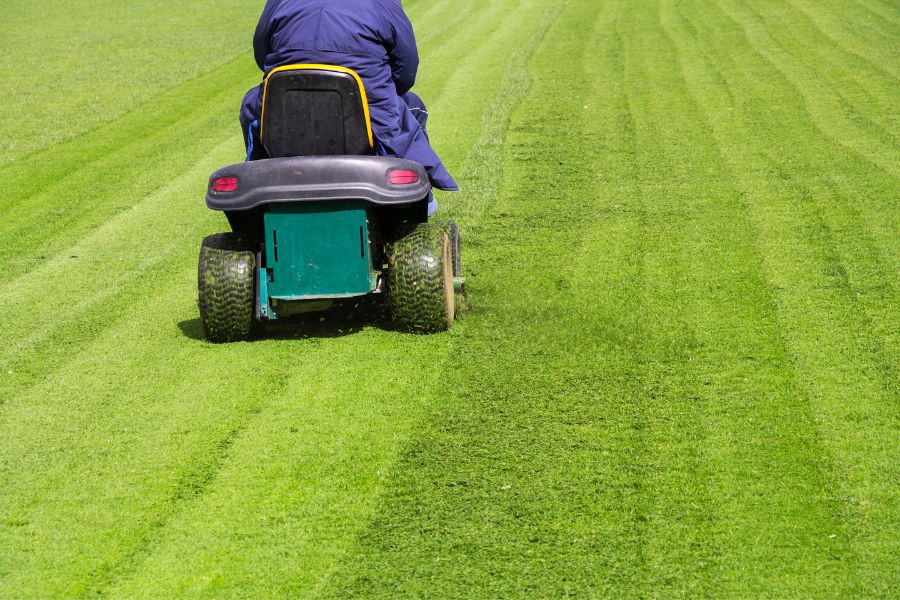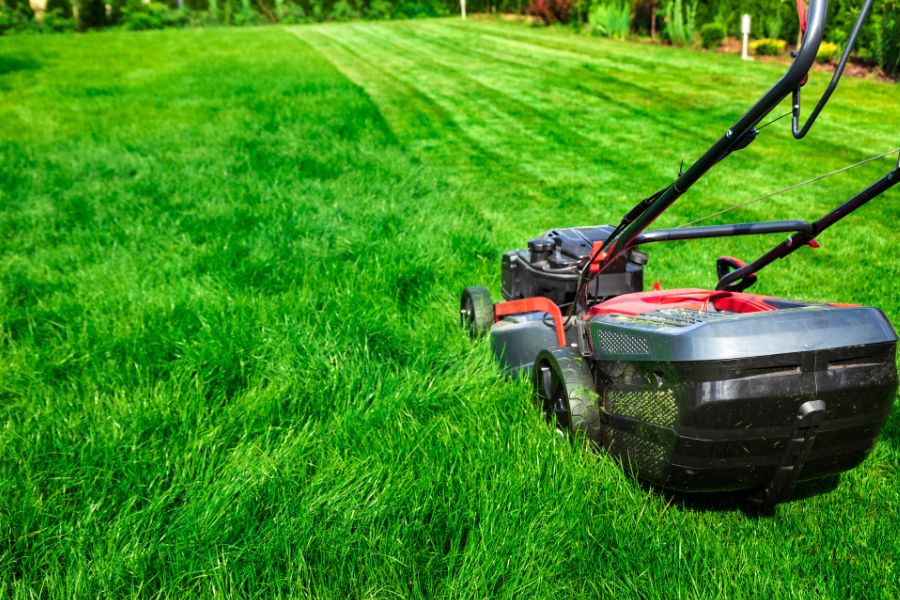
When Should You Mow New Grass?
Growing a beautiful green lawn from scratch is exciting and meticulous. Until you get stuck in a rut, confused and wondering: when should you mow new grass?
The eagerness to see a well-manicured lawn often has many reaching for their mowers too soon. However, you must introduce mower blades to a newly seeded lawn at the right time for its health and longevity.
To answer this question, we’ll spotlight the details on grass care and how to keep your lawn healthy from the very first seed to the lush expanse of green.
How New Grass Grows
The journey to a healthy lawn begins with planting grass seed. When these seeds are sowed into the soil, they germinate. The first signs of life will be tiny grass blades piercing through the earth’s surface, marking the birth of your new lawn. As these grass blades grow taller, they also start to thicken, preparing themselves for their eventual meeting with the mower blades.
However, these initial stages of growth are crucial and delicate. Mowing too early can stress the new grass, making it vulnerable to disease pests and potentially uprooting the grass blades. Hence, while you might see grass clippings as a sign of progress, premature mowing halts the growth of your new lawn. This sets back all the effort you put into planting and nurturing the grass seed.
Moreover, a newly seeded lawn requires a different set of care routines than a mature one. The roots of the new grass are still shallow, and they need adequate water and sunlight to strengthen and deepen their hold in the soil. This solid foundation will eventually lead to a robust and healthy lawn that withstands mower blades’ shearing action and continues to thrive.
Why is Timing Crucial?
Establishing a lush lawn requires more than planting seeds and keeping them watered. A crucial component often overlooked is the timing of the first mow and maintenance. The eagerness to see a manicured green lawn sometimes leads homeowners to prematurely introduce the lawn mower to young grass.
Young grass plants are tender, and their roots are not yet profoundly established in the soil. Using a lawn mower too soon can damage these fragile grass plants and uproot them due to their shallow grass roots.
Moreover, mowing new grass prematurely exposes the lawn to diseases. A cut from a mower blade creates an entry point for pathogens, leading to various lawn diseases. Additionally, stressed grass from early mowing is more vulnerable to weed infestation, as it allows weeds to outcompete the young grass.
Existing grass in an established lawn has the resilience to recover from regular mowing. However, new lawns, especially those with varieties like warm-season grasses (e.g., buffalo grass), need ample time post-planting. This time enables them to reach a level of maturity where they can handle the shearing action of a mower blade.
General Guidelines for Mowing New Grass
Mowing new grass requires precision, care, and, most importantly, patience. Adhering to the following guidelines will ensure a thriving, lush lawn:
Right Height
Before you bring out the lawn mower, ensure the grass has reached at least 3 to 4 inches in height. This ensures the grassroots have had time to deepen and stabilize.
The Dilemma of Wet Grass
Never mow when the grass is wet. Wet grass tends to clump, leading to an uneven cut. Moreover, it’s easier for diseases to spread in wet conditions.
Mower Blade Maintenance
A sharp mower blade promotes a clean cut. Dull blades tear grass plants, stressing them and making them prone to diseases.
Mowing Intervals
Initially, try only to cut off the grass blade’s top third. This boosts a stronger root system and a healthier, green lawn.
Leave Grass Clippings
Instead of collecting and disposing of them, leave grass clippings on the lawn after mowing. They decompose quickly and return valuable nutrients to the soil, fostering a healthier growth environment for the existing grass.
Variety Matters
Like buffalo grass, warm-season grasses have different mowing needs than cool-season varieties. Always ensure you’re familiar with the specific needs of your lawn variety.
Comparing Lawns
Avoid comparing mowing timelines of new lawns to established ones. An existing lawn has already undergone the initial vulnerable phase and can handle regular mowing better than a newly seeded lawn.
Specific Guidelines for Different Types of Grass

When it comes to mowing, not all grasses are created equal. The type of grass on your lawn plays a pivotal role in determining when and how you should mow, especially during the initial stages. Check out the guidelines tailored to different types of grass:
Cool-season grasses (e.g., Kentucky bluegrass, fescue)
Mowing Height: For these grasses, wait until they are about 3.5 to 4 inches tall before mowing. Your initial mowing height should be around 2.5 to 3 inches.
Watering: Keep the soil moist with consistent watering, especially during germination. This helps the grass develop strong roots.
Warm-Season Grasses (e.g., Bermuda, buffalo grass):
Mowing Height: Warm-season grasses generally thrive when kept a bit shorter. Wait until the grass grows to about 2 to 3 inches, and set your mowing height at approximately 1.5 to 2 inches for the initial mows.
Watering: While they’re known for their drought tolerance, new sod of warm-season grasses still requires regular and consistent watering to establish roots.
Simple Mowing Tips for New Grass
After preparing your soil and planting, mowing your lawn, especially a newly seeded one, requires precision. Here are some essential tips to keep in mind:
Don’t Cut Too Much
Never mow more than a third of the grass blade in a single session. Removing too much can stress the grass and inhibit its growth.
Use Sharp Blades
Always ensure your mower is equipped with sharp blades. Dull blades tear the grass instead of cutting it, leading to a ragged lawn appearance and exposing the grass to diseases.
Mowing Direction
Change your mowing direction each time. This encourages the grass to grow upright and prevents the formation of wear patterns.
Grass Clippings
After mowing, you can leave the grass clippings on the lawn as they can decompose and act as a natural fertilizer. However, if you have many clippings, consider adding them to a compost pile to avoid smothering the grass.
Consistent Care
Apart from mowing, new grass requires consistent watering and occasional feeding to thrive. A balanced lawn care routine keeps the grass healthy and helps withstand mowing.
Watch the Sod
If you’ve installed new sod, be extra careful during the first mow. Ensure the sod has rooted into the soil beneath. Test this by gently tugging at a corner of the sod; it’s safe to mow if it doesn’t lift easily.
Additional Care Tips for New Lawns
Starting a new lawn or gardening is like nurturing a newborn – it demands time, attention, and patience. Mowing is just one aspect of lawn care, and many ponder the question, “When should you mow new grass?”
There are several other facets to consider when tending to a newly seeded lawn. Here are some additional care tips to ensure your new lawn flourishes:
Watering
Young grass seeds and newly germinating blades require consistent moisture to thrive. It’s essential to keep the soil moist but not waterlogged. Regular, light watering is preferable over occasional deep watering for new lawns.
Fertilizing
About 6-8 weeks after the grass seed has germinated, consider applying a starter fertilizer to provide the new grass with essential nutrients. Always follow the manufacturer’s guidelines when applying any fertilizer.
Weed Control
It’s not uncommon for weeds to appear alongside new grass. While using herbicides is tempting, it’s best to hold off until the lawn is more established. Instead, consider manual removal for persistent weeds during the early stages.
Summary
The sight of fresh green blades sprouting from the soil brings immense satisfaction, but the road to a lush lawn demands dedication and care. From deciding when you should mow new grass to ensuring your mower blades are in top condition, every step is integral to the health of your lawn.
If you adhere to the best practices and provide consistent care, your newly seeded lawn will soon transform into a verdant oasis, a testament to your efforts and commitment.
You may also like
Written by coral
| M | T | W | T | F | S | S |
|---|---|---|---|---|---|---|
| 1 | 2 | |||||
| 3 | 4 | 5 | 6 | 7 | 8 | 9 |
| 10 | 11 | 12 | 13 | 14 | 15 | 16 |
| 17 | 18 | 19 | 20 | 21 | 22 | 23 |
| 24 | 25 | 26 | 27 | 28 | 29 | 30 |


Leave a Reply